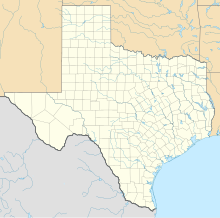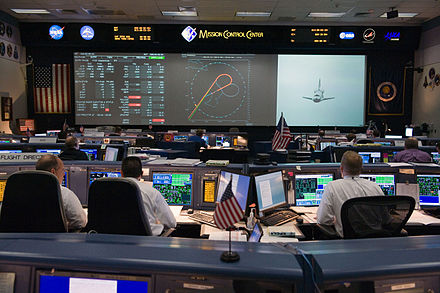Lyndon B. Johnson Space Center
Coordinates: 29 ° 33 '23 " N , 95 ° 5' 15" W.
The Lyndon B. Johnson Space Center ( JSC ) has coordinated the US manned space program since 1961 . It is located in Houston ( Texas ) and is an institution of NASA . In total, more than 14,000 people are employed on the 655 hectare site.
The space center, posthumously named after former US President Lyndon B. Johnson , houses the Mission Control Center (MCC) - the radio nickname is "Houston", the headquarters of the JSC - from which all manned space flights since Gemini 4 in June 1965 have been directed become. Previously, the tour was at the Langley Research Center in Virginia , where the so-called Space Task Group had been housed since November 1958 . This had been commissioned with the implementation of the Mercury program . Today, flights to the International Space Station are monitored from the MCC . The US astronaut training center is also located at the JSC.
history
When US President John F. Kennedy announced in May 1961 the national goal of sending a person to the moon and safely returning to earth within a decade, NASA was looking for a location for a new center. It was supposed to bundle and coordinate the space agency's Apollo program .
In August 1961, NASA boss James E. Webb commissioned a group of four under the direction of John F. Parsons to select the right site for the Space Task Group. 23 locations were identified and each was visited during a two-week inspection trip. After that there were still nine areas in the race.
The Parsons team favored the MacDill Air Force Base in Tampa ( Florida ). Houston and a material depot in Benicia ( California ) occupied the next places. When the US Air Force did not want to close its MacDill base as initially intended, the choice for the new NASA center fell on Houston and was announced by Director Webb on September 19, 1961. Just three days later, the first representatives of the US space agency traveled to Texas.
The founding date of the Manned Spacecraft Center (MSC), as the JSC was originally called, is October 24, 1961. On that day, a small NASA delegation moved into some rooms - two empty clothing stores - in the Gulfgate Shopping Center in the east of the city. Houston was so excited about NASA's decision to set up its new center in the Texas metropolis that local companies quickly converted the space into offices for free. Some Continental Airlines stewardesses have even been loaned out as receptionists.
The MSC was built on an unused site that Rice University donated to NASA. Until then, herds of cattle had grazed on the 400 hectares. The land is located in southeast Houston, in the Clear Lake District, the former suburb of Clear Lake City, which was incorporated in 1977. In addition, NASA acquired a 240-hectare site in order to have a direct connection to the highway. Together with an abandoned oil drilling property, the space agency had 655 hectares of land.
In order to move staff to Houston as soon as possible and begin work while the MSC was being built on the new site, half a dozen offices and buildings were rented from companies. The studios of the University of Houston, in which the internal television program was produced, were converted into a computer center, and the machinery was housed with a beverage company. Most of the employees were billeted in the barracks of the old Air Force airfield at Ellington Field . In order to be able to find their way around, they used site maps on which the various provisional locations were entered.
The MSC began operations (in the rented buildings) on March 1, 1962 when the director of the new NASA facility, Robert R. Gilruth , moved into his offices. After almost a year that the design office needed for the designs, the contracts for the construction of the first 11 buildings were awarded in December 1962. A total of US $ 60 million was available to NASA for the MSC in the first year. After a year, the new buildings were completed and 2100 NASA employees moved into their rooms.
The construction of the MCC alone cost the equivalent of 2.7 billion euros.
On February 17, 1973, the MSC was given its current name in honor of former US President Lyndon B. Johnson .
The Mission Control Center, which goes by the name of Christopher C. Kraft Jr. Mission Control Center , was listed as a building on the National Register of Historic Places and designated a National Historic Landmark in October 1985 .
Previous leaders
The JSC has been headed by the following people throughout its history:
- 11/1961 to 01/1972: Robert Gilruth
- 01/1972 to 08/1982: Christopher C. Kraft
- 08/1982 to 01/1986: Gerald D. Griffin
- 01/1986 to 10/1986: Jesse Moore
- 10/1986 to 08/1993: Aaron Cohen
- 08/1993 to 01/1994: Paul Weitz (acting)
- 01/1994 to 01/1996: Carolyn Huntoon
- 01/1996 to 02/2001: George Abbey
- 02/2001 to 03/2002: Roy Estess (acting)
- 03/2002 to 11/2005: Jefferson Howell
- 11/2005 to 12/2012: Michael Coats
- 01/2013 to 05/2018: Ellen Ochoa
- 05/2018 until today: Mark S. Geyer
Web links
- JSC homepage (English)
- Henry C. Dethloff: Suddenly Tomorrow Came ... A History of the Johnson Space Center (History of the JSC in 17 chapters, English, PDF)
Individual evidence
- ^ Rudolf Metzler: Hello Earth . The youth space book. 5th edition. Loewes Verlag Ferdinand Carl KG, Bayreuth 1969, ISBN 3-7855-1597-9 , chapter: In the space ghetto of Husten, p. 268 (The book gives 5.2 billion marks; converted at an exchange rate of 1 DEM = 0.51129 EUR, see German marks ).
-
^ Apollo Mission Control Center on the National Register of Historic Places , accessed February 24, 2020.
Listing of National Historic Landmarks by State: Texas. National Park Service , accessed February 24, 2020. - ^ Johnson Space Center Directors. NASA, March 30, 2006, accessed September 14, 2009 .
- ^ NASA Announces Leadership Changes at Glenn and Johnson. In: NASA Press Release 12-398. NASA, November 16, 2012, accessed November 19, 2012 .



